Can You Rescue Poorly Stored Mozzarella? | The Food Lab
The number one rule for fresh mozzarella is never, ever refrigerate it, as it ruins the texture. But can anything be done to rescue poorly stored cheese?
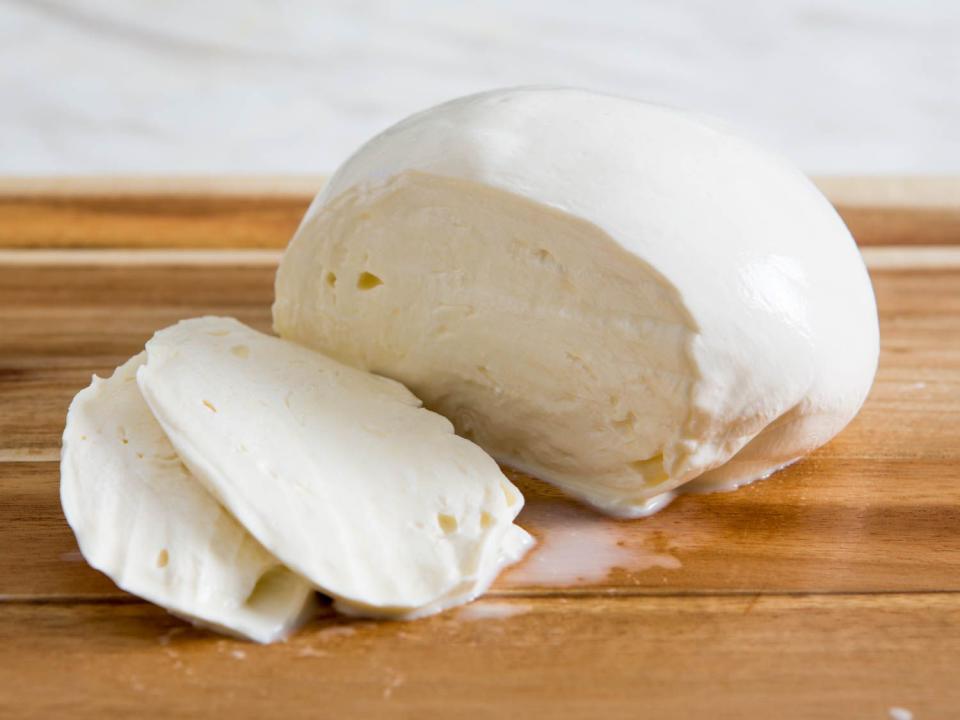
Serious Eats / Vicky Wasik
When you've been working at Serious Eats for long enough, you eventually start to notice little patterns in Overlord Ed's personal quirks. You'll come in early in the morning to find the shower in the back bathroom recently used and Ed's green towel hung up over the bar, but no Ed in sight and wonder to yourself, did Ed come in really early, take a shower, then go back home? You'll hear his distinctive walk coming down the hall and brace yourself, because you know that he's walking in with a bag full of pastries. "I just stopped in at François Payard for breakfast. I got one of everything on the menu. Robyn—can you take photos?"
Then we get to his odd relationship with the refrigerator. Step into Serious Eats and get ready to forget everything you know—or thought you knew—about what should and shouldn't go in the refrigerator. Half eaten bag of chips from the counter? Into the fridge they go. Leftover fried chicken?
Don't even think about it. Ed's been known to eat three-day-old unrefrigerated fried chicken from time to time. Candy and chocolate? Definite fridge material. Mutton barbecue shipped from Owensboro Kentucky? The fridge will ruin it, insists Ed.
But the cardinal rule of the fridge, the one that must never be broken, is that fresh mozzarella should never, under any circumstances, pass the threshold of the refrigerator door.
It ruins the cheese, he says. It takes what was once moist, luscious, and rich, and turns it into dry rubber.
So...is Ed right?
Ed's been right about far stranger things in the past, so we decided to answer two questions: Is Ed right? And if Ed is right, is there any way to resuscitate mozzarella once it's been exposed to the darkness inside the closed refrigerator door?
Is Refrigerating Mozzarella Bad?

Serious Eats / Robyn Lee
The first part of our test was simple. We happen to be located directly across the street from DiPalo Selects, one of the finest mozzarella-makers in the city. They make their mozzarella from fresh curds several times a day, lightly salt it, wrap it up, and sell it directly from the counter, never letting it hit the refrigerator.
I stopped by early in the morning to pick up a few freshly made balls. As it turns out, Jim Lahey happened to be in the shop talking provolone with Sal DiPalo, one of the DiPalo brothers. Seeing as I had the king of mozzarella and the king of bread in one place together, seemed like the perfect opportunity to get some more opinions on the matter.
They were unanimous: do not refrigerate mozzarella. Sal says, "you could do it, but it's never going to taste the same. That's why we make ours fresh a few times a day. We don't want to refrigerate it." Lahey concurred: "It drives out all the whey and tightens it up. You get rubbery mozzarella."
Ed's story looked like it was gaining a bit of credibility. I took the balls back to the office, carefully weighed them, then placed one in the refrigerator, one in the freezer, and left one on the counter. After three hours, I returned all three balls to the counter to allow the frozen ball and the refrigerated ball to return to room temperature before I had everybody in the office to completely blind-taste them at the end of the day.
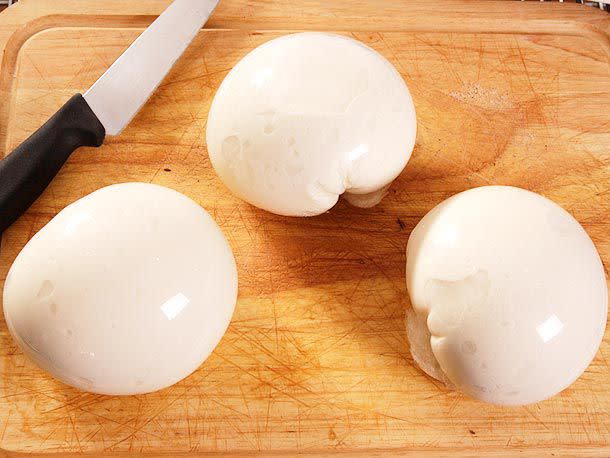
Serious Eats / Robyn Lee
I asked each person to rank the three balls. The verdict? Ed was absolutely right. In a blind set up, tasters were almost unanimous in declaring the fresh mozzarella the best and the frozen mozzarella the worst.
The fresh mozzarella was moist and tender, releasing plenty of milky white whey as you cut or bit into it. The curds were soft under your teeth, with no hint of rubberiness. The refrigerated mozzarella, on the other hand, was firmer and far less juicy, while the frozen ball came out almost like rubber with very little juice released as you ate it.
The interesting part, however, came when I looked at the containers the mozzarella balls were stored in. Here's what the container for the fresh ball looked like:
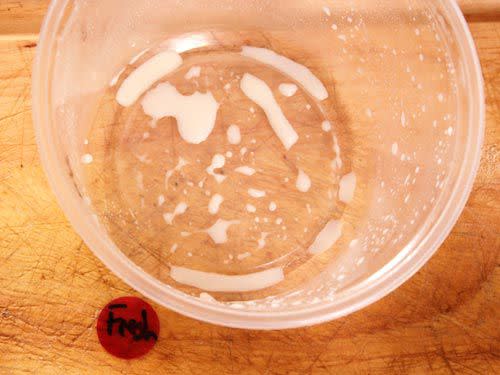
Serious Eats / Robyn Lee
See all that milky whey on the bottom? Now take a look at what the frozen ball left behind:
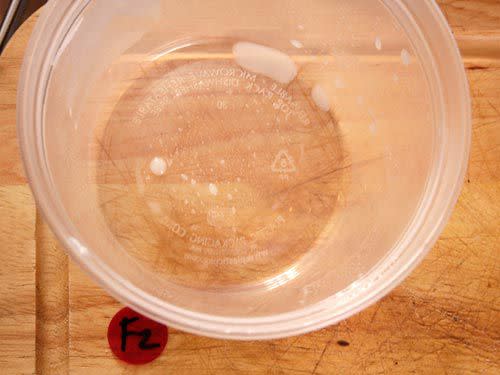
Serious Eats / Robyn Lee
Next to nothing. Just to confirm this observation, I weighed the mozzarella balls again just before we tasted them. It turns out that the frozen mozzarella had lost pretty much no weight, while the fresh mozzarella had lost a few grams, which corresponded to the amount left at the bottom of its cup.
So the frozen mozzarella technically contained more whey in it than the fresh mozzarella.
So, why the heck does it taste dryer?
I did a bit of research and found my answer in an article from the Journal of Food Science from 1999 (Proteolysis and Functional Properties of Mozzarella Cheese as Affected by Refrigerated Storage, page 204). In this study, a similar experiment was carried out over a longer time frame. Just as we observed, they noticed a dramatic decrease in the amount of expressible serum (that's a fancy way of saying "whey you can squeeze out") during the first days of refrigeration that eventually maximize and plateau at the 10-day mark. This is due to chemical changes in the protein matrix that forms the cheese.
To put it simply: refrigerated mozzarella holds onto its moisture better. So it's not that fresh, unrefrigerated mozzarella is actually more moist than refrigerated mozzarella, it's simply that it more readily gives up that moisture to your mouth, making it seem moister.
What I found particularly fascinating about the study was this line:
"Results indicated that, after the tenth day neither the frozen nor refrigerated mozzarella cheeses should present the free moisture problems normally found in fresh mozzarella cheese."
The researches actually present free moisture as a defect in mozzarella! The type of aged, low-moisture mozzarella cheese destined for shredding is purposely refrigerated for at least 10 days in order to make sure that it doesn't release moisture as it cooks, instead melting into the familiar stretchy string you find on a New York-style pizza.
That's why the fresh mozzarella on a Neapolitan pie can often turn the pie soupy with all the whey that gets released. It also explains why my homemade Neapolitan pies are never quite as moist and wet as those that I get at some of the shops in the city that make their own mozzarella fresh each day—I usually buy refrigerated mozzarella.
So the new question is: Is there a way to resuscitate refrigerated mozzarella and return it to its original, juicy form?
Fixing My Mozz
Once again, Ed had a suggested solution: just re-soak the mozzarella in whey until it can absorb enough to again taste juicy.
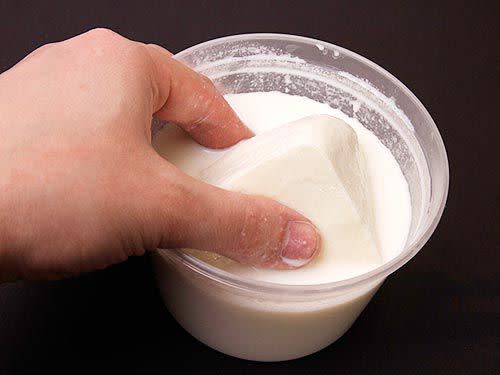
Serious Eats / Robyn Lee
I refrigerated a few balls of mozzarella for a week until they were good and rubbery, then attempted to rescue them using a few different methods:
Water at 68°F
Water at 110°F
Water at 145°F
Whey at 68°F
Whey at 110°F
Whey at 145°F
Milk at 68°F
Milk at 110°F
Milk at 145°F
The whey I made by warming up milk and adding vinegar until it curdled. I strained out the curds (which, by the way, are excellent as a homemade ricotta substitute), and kept the chalky whey for soaking.
Each ball was dropped into their bath and allowed to soak for one hour. I did not maintain the temperature of the batches above room temperature, rather I let them cool naturally.
Of all the tests, the watery versions were the biggest failure. The mozzarella came out moister, sure, but also way, way blander.
Between the milk and the whey, both were good, but flavorwise I actually preferred the version made with whole milk. Finally, 110°F was the way to go. The room temperature milk didn't get absorbed into the cheese as easily, while the hot milk actually ended up cooking the mozzarella further, resulting in a tough, rubbery, squeaky texture around the exterior.
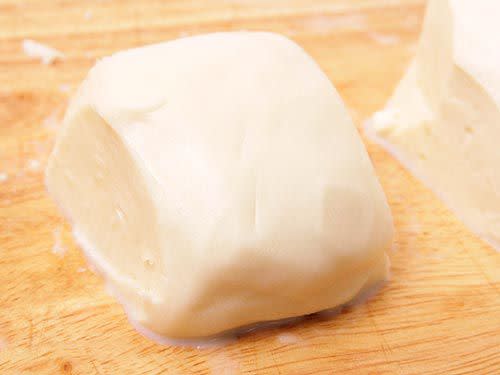
Serious Eats / Robyn Lee
I did notice one big problem off the bat: the milk-soaked mozzarella came out juicy, but it was still blander than it was when it went in. What's up with that?
Tasting the milk post-soaking answered my question: the milk was salty, indicating that some of the salt in the cheese was getting leeched out. The solution? Just salt the milk before adding the cheese. a teaspoon of kosher salt per cup was the right amount.
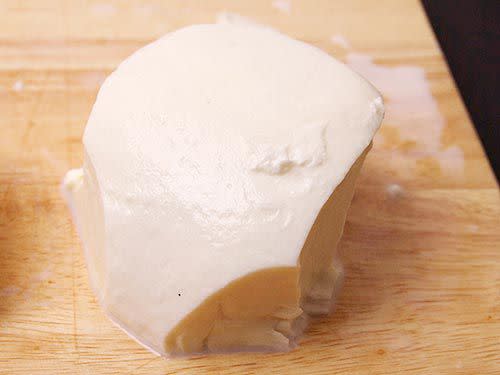
Serious Eats / Robyn Lee
The final test was to determine whether my soaked cheese would make its way past Ed's mozzarella radar. I set up a triangle test between three batches of cheese. Two of them were freshly made from DiPalo's the third was refrigerated for a week, then soaked for 1 hour in a salty milk bath that started at 110°F (that's about what a very hot bath is like—you can stick your hand in it without burning).
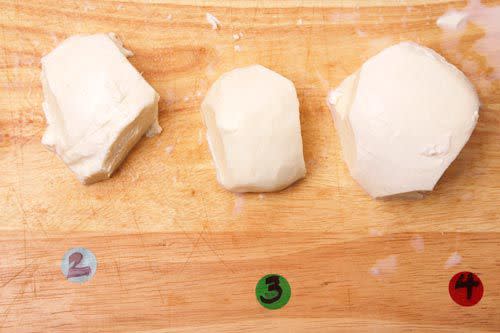
Serious Eats / Robyn Lee
Ed tasted... and tasted... and tasted some more... until all three balls of cheese were almost completely finished. Conclusion? He could not pick out which of the cheeses was the odd one out. I'd call that a success.
So the next time you've got yourself some fresh mozzarella from the grocery store, do you and your tastebuds a favor: take it out of the fridge and give it an hour-long soak in a warm, salted milk bath. Heck, you might even be able to fool your guests into thinking that you made it fresh right in your own kitchen.
Now I've just got to convince Ed to work on modifying his fried chicken refrigeration policy (hint: Ed, you can just re-fry it the next day).

